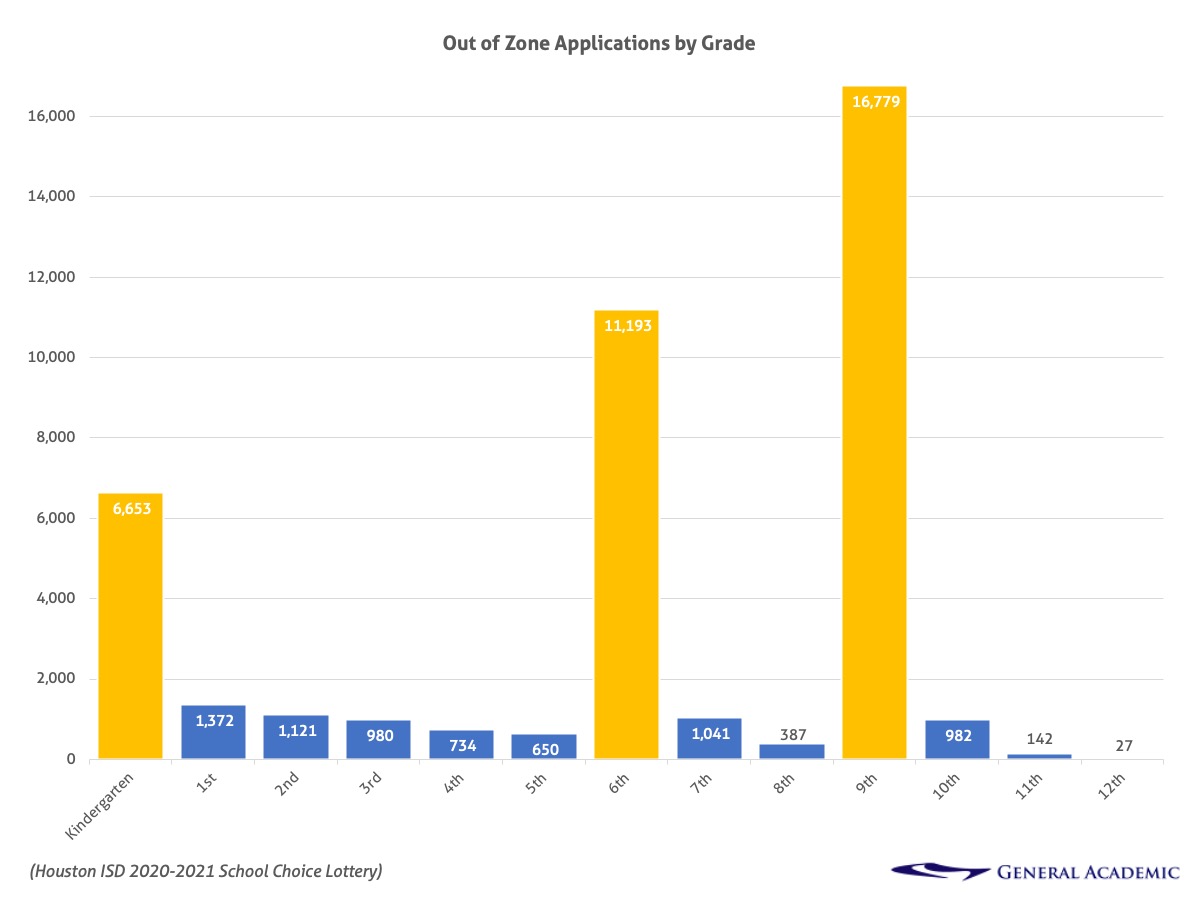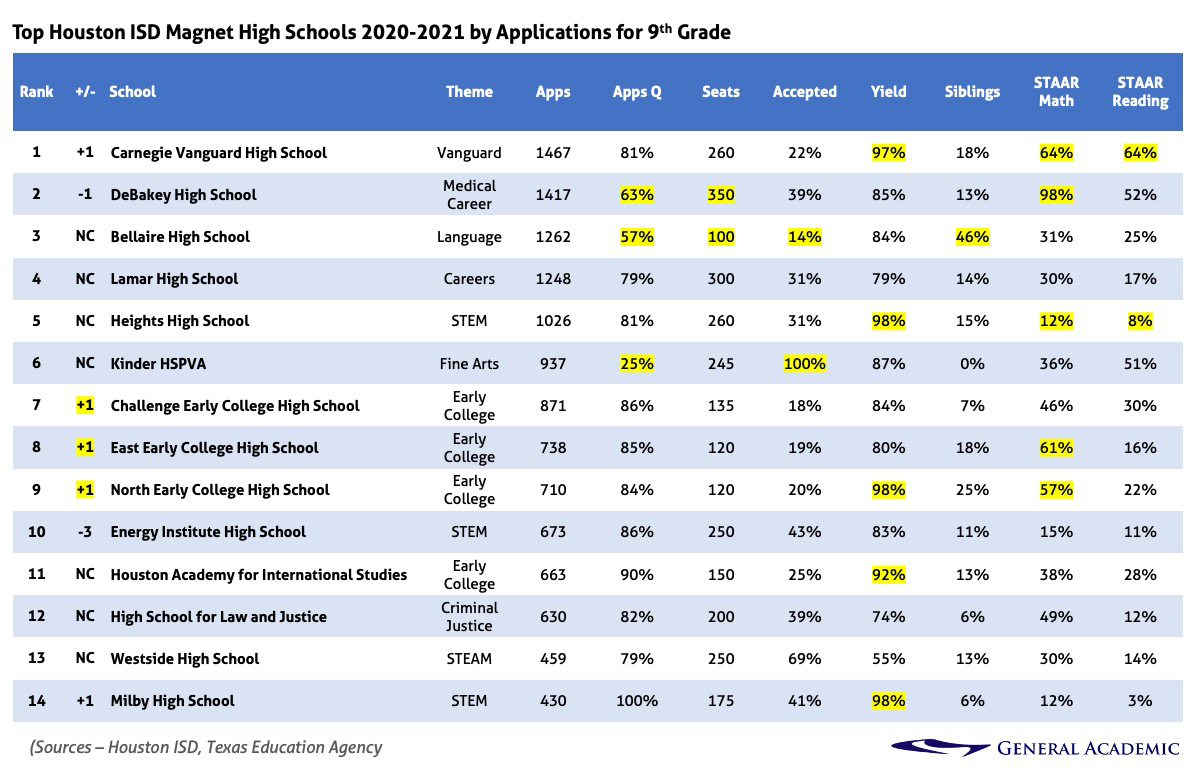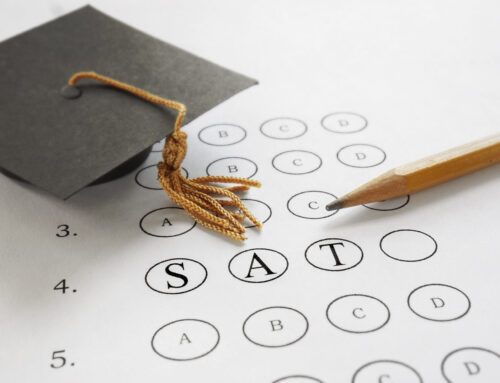
Analysis of Houston School Choice Lottery for 2020-2021
 The most popular Houston ISD (HISD) magnet schools for 2020-2021 are River Oaks Elementary School, Pin Oak Middle School, and Carnegie Vanguard High School.
The most popular Houston ISD (HISD) magnet schools for 2020-2021 are River Oaks Elementary School, Pin Oak Middle School, and Carnegie Vanguard High School.
Families had about a 10%-20% chance of winning the lottery for admission to a highly desirable HISD magnet school for kindergarten, sixth, or ninth grade—the prime entry years for elementary, middle, and high school respectively.
Parents gravitated toward rich elementary schools; they disliked the district’s middle schools, but they seemed much more pleased with the high schools—these are the other key takeaways from this year’s lottery.
This article is old. Click here for an analysis of the 2021-2022 school year lottery.
A little less than 8% of HISD students participated in this year’s annual School Choice Lottery. 16,249 families submitted an average of 2.6 applications each for a total of 42,061 applications submitted during Phase I of the lottery. The number of applications submitted was up marginally from last year’s 2.4 but still only about half of the 5 program limit.
Participation in the lottery was down for the second year in a row by about 10% versus 2019 and nearly 22% versus two years ago. These declines are outpacing HISD’s overall decrease in popularity; the district’s enrollment peaked at just over 216,000 students in the 2016-2017 school year and stood at just over 210,000 for the 2019-2020.
Equating Magnet Popularity with a Good School
Identifying what defines a “good school” is a little like trying to do the same kind of comparison about the children that attend them—it’s highly subjective. For many parents, good schools are defined by high test scores or national and state recognition. For other parents, a good school is just one in a wealthy neighborhood or with new buildings.
HISD’s annual School Choice lottery is a unique opportunity for the traditional market forces of supply and demand to identify the district’s best schools. Whereas many families live in areas where they must attend a specific neighborhood school, the lottery enables every family in Houston to apply for a chance to attend a school of their choice.
Assuming that market forces work correctly, the “best Houston schools” will therefore also be the ones where the most families apply to (application numbers) and attend (yield rate) when given an offer of admission.
Houston ISD Struggles with Challenging Year
Even before the pandemic, HISD was already having a difficult time. Citing failing schools and a dysfunctional Board of Trustees, the Texas Education Agency (TEA) announced in November 2019 that it intended to replace HISD’s elected school board with a state-appointed one. However, HISD received a temporary court-approved reprieve in January 2020, and the case remains mired in court.
Amid the political and administrative drama, Houston residents acted decisively with their votes and replaced much of HISD’s Board of Trustees with an all-female leadership in November 2019. And now in the middle of a global pandemic, the district—like the rest of the world—is contending with how to resume schooling while mitigating risks to families, educators, and staff alike.
Summary of Key Findings
- High STAAR scores and rich neighborhoods drive desirability of elementary and middle schools; however, marketable differentiation increases at high school especially at Early College programs. Only about 25% of magnet programs are popular.
- HISD’s Middle Schools are very unpopular. About 20% of the district’s enrollment leaves between 5th and 6th grade only to largely return for 9th grade.
- Families are unaware of admissions requirements or aren’t able to meet them. For example, at vanguard elementary schools, nearly 60% of applicants didn’t qualify as gifted and talented and therefore were automatically rejected.
Introduction to the Houston ISD School Choice Lottery
While all students are automatically accepted into the school in their zoned neighborhood, the annual School Choice lottery allows families to apply to schools in other neighborhoods or to special schools that are “equal opportunity” in that none of the students come from the surrounding neighborhood.
The ability to attend an “out of zone” (OOZ) school is particularly appealing if families live in a neighborhood zoned to a relatively poor performing school but cannot afford to spend an average of $3.5 million to buy into or rent in the neighborhood zone of number one River Oaks Elementary for example.
However, parents must pay attention to a school’s unique program and admissions requirements. While some magnet schools enforce no requirements other than families be residents within HISD’s attendance zone, many schools have minimum qualifications such as that students be designated as Gifted and Talented (River Oaks Elementary), have a talented tongue for languages (Bellaire High School), or possess surprisingly good artistic ability (High School for the Performing and Visual Arts). About 30% of applications this year were automatically rejected, because students did not actually meet the qualifications to attend a certain school.
For the 2020-2021 academic year lottery, students could have applied to a maximum of five schools, and they had to rank their schools in order of preference. The rank order did not affect the outcome of the lottery; it only affected how students were placed on a waitlist. If a student was admitted into a school they ranked higher than another school, they would not have been waitlisted at their lower-ranked school. The intended effect of this policy is to shorten waiting lists for all schools.
Timeline of the 2020-2021 Academic Year Lottery
- December 6, 2019 — Deadline to submit application for Phase I of the School Choice Lottery
- December 7, 2019 — Deadline to request testing for Gifted and Talented qualification required for vanguard schools
- January 30, 2020 — Families were notified of the lottery results
- February 13, 2020 — Deadline for families to accept their offer of admission
Qualified applicants are thrown into a randomized lottery. There are generally no ways to gain an advantage other than to:
- Take the necessary steps to be qualified to attend the desired school;
- Already have a sibling enrolled at a school and want to attend concurrently with the sibling next year;
- For pre-kindergarten only, qualify as disadvantaged.
Students may technically apply to most magnet schools up until the first day of school on September 8, 2020 (later than normal due to Covid). However, applications submitted after Phase I are essentially guaranteed not to place into any desirable school, because all the seats would be already taken. Students will continually move off of the waiting list until the first day of school.
How to Read the Tables
- Theme indicates the type of magnet school; parents can learn more about the different themes at HISD’s website
- Apps refers to the number of applications received from out of zone (OOZ) students and excludes zoned neighborhood students
- Apps Q is the percentage of OOZ apps that are actually qualified to be considered for admission
- Seats are the number of spaces available to OOZ students and excludes availability for zoned students
- Accepted is the percent of qualified applicants offered admission on January 30, 2020
- Yield is the percent of applicants who had accepted their offer of admission by February 13, 2020
- Siblings are the percent of OOZ applicants from siblings of currently enrolled students
- Home Value is the average listing price of homes in the school’s neighborhood zone or immediate vicinity
- STAAR Math is the percent of all students at the school who earned the “Masters” designation on the STAAR math tests
- STAAR Reading is the percent of all students at the school who earned the “Masters” designation on STAAR reading tests
HISD presented this data as accurate on July 28, 2020, (data was delayed significantly due to HISD’s central office closing due to Covid) but the numbers will change continuously until school starts on as students finalize their enrollment plans. Click here to download the original dataset provided by Houston Independent School District (HISD).
Top Houston ISD (HISD) Magnet Elementary Schools
The top Houston ISD magnet elementary schools are River Oaks, Rogers, Harvard, Lovett, and Kolter. Other top elementary schools include West University, Twain, Roberts, and Bush; however, these schools are only available to zoned neighborhood students.
For the 2020-2021 academic year, 2,503 students submitted 6,653 applications for kindergarten to 58 HISD elementary schools. These numbers were essentially flat versus the previous year’s lottery. Kindergarten is the “prime entry” year for most HISD Elementary schools, meaning that it is the year when most seats are available. River Oaks and Rogers elementary schools are the most popular by far, having received nearly twice as many applications as the third most popular Harvard Elementary. River Oaks Elementary is located in the prestigious River Oaks neighborhood; Rogers is an application-only school located near the Galleria, and Harvard Elementary is located in the Houston Heights.
River Oaks and Rogers elementary schools are the most popular by far, having received nearly twice as many applications as the third most popular Harvard Elementary. River Oaks Elementary is located in the prestigious River Oaks neighborhood; Rogers is an application-only school located near the Galleria, and Harvard Elementary is located in the Houston Heights.
The lucky 154 students, about 16% of qualified applicants, who won seats at the top 3 schools knew their good fortune as 98% of them accepted the offer within two weeks of being notified.
Parents are really only interested in about 17 of the 58 magnet elementary schools, which collectively offered 2,384 kindergarten seats. The top 17 schools (29%) received 85% of the applications. At these top 17 schools, parents had nearly a 30% chance of admission and accepted that offer 88% of the time.
These schools are academically rigorous when measured by STAAR scores. On average 44% of students score at the highest level of the STAAR (“Masters”) in Math and Reading versus 23% and 20% respectively for HISD as a whole.
More than half of applicants to the vanguard schools including River Oaks, Rogers, and Travis failed to qualify as gifted and talented; vanguard schools only accepted gifted and talented students. This large number of disqualified applicants meant that the qualified population ended up having their chances of admission more than double.
The Dual Language schools Wharton (Spanish) and Mandarin (Chinese) increased in popularity this year. Wharton in particular jumped three spots, which is likely driven by the completion of its comprehensive campus renewal. The Mandarin Immersion School continues to stand out not only for its increasing popularity but also for its very high STAAR test score results.
However, several of these otherwise popular schools stand out in less compelling ways. At Herod Elementary, only 34% of applicants qualified as gifted and talented. Wilson Montessori stands out for its very limited availability to magnet transfers and for low STAAR math scores. Askew Elementary is notable for its low desirability among families as evinced by poor yield percentages.
Sibling Applications Demonstrate Strong Parent Satisfaction
Siblings of currently enrolled students have a greater chance of admission, because up to 25% of a school’s available seats are reserved exclusively for siblings. If more siblings apply than those 25% of reserved seats allow, then siblings get to participate in both the “sibling lottery” and the general lottery.
The number of siblings participating also helps to show parent satisfaction with a school. If parents of a currently enrolled student are happy then it follows that they would be likely to try to send their younger children to the same school.
Parents seem satisfied with these top 17 schools as sibling applicants account for an average of 53% of available seats. Parents seem particularly happy at Harvard, Travis, and Wilson where sibling applicants could account for as many as 92% of the available seats.
The Best Performing Elementary Schools are Increasingly Out of Reach
Some of the district’s top performing elementary schools by STAAR scores are inaccessible via magnet programs. West University, Roberts, Twain, and Bush elementary Schools are not part of the magnet lottery, because their popularity among neighborhood families means that there is no space available to accommodate out of zone, magnet transfer students.
With the exception of Bush Elementary in far west Houston, West University, Twain, and Roberts are in neighborhoods where home values generally cost $1 million or more.
Wharton, Oak Forest, and Garden Oaks are likely to also exit the magnet lottery program in the near future. These schools are also located in increasingly gentrifying neighborhoods.
Top Houston ISD (HISD) Magnet Middle Schools
The top Houston ISD middle schools are Pin Oak, Lanier, and Rogers. Pershing is a distant fourth. While third in popularity overall, Rogers is the district’s best middle school by STAAR test scores.
For the 2020-2021 academic year, 4,099 students submitted 11,193 applications for sixth grade to 34 HISD middle school programs. These numbers were down slightly versus the previous year’s lottery. Sixth grade is the “prime entry” year for most HISD middle schools, meaning that it is the year when most seats are available. Pin Oak, Lanier, and Rogers remain the most popular middle schools in the city with Pin Oak being the most favored by far with nearly double the applications of Rogers. However, Rogers is academically the best middle school in HISD by STAAR scores.
Pin Oak, Lanier, and Rogers remain the most popular middle schools in the city with Pin Oak being the most favored by far with nearly double the applications of Rogers. However, Rogers is academically the best middle school in HISD by STAAR scores.
Of the 11 middle schools that received more than the average number of applications, families had a 29% chance of admission; however, those chances fell dramatically to just over 10% among the top 3.
Yield rates among the top 5 middle schools – Pin Oak, Lanier, Rogers, Pershing, and Meyerland were near 100% as admitted families eagerly accepted their offers of admission.
Pin Oak and Rogers had very high “loyalty rates,” meaning that parents of currently enrolled students seemed happy enough to also want to send their younger children to the same school. These two schools could fill upwards of 50% of their available seats with just siblings alone if they were allowed to do so; only 25% of seats are reserved for siblings after which families must still participate in the general lottery.
Limited Middle School Choices Drive Families Away
According to TEA enrollment data for 2019-2020, HISD loses about 20% of students making the transition from 5th grade elementary to 6th grade middle school as seemingly dissatisfied families left the district for suburban, private, or charter school alternatives.
It doesn’t help that with 34 programs on offer, HISD offers the fewest choices at middle school compared to elementary (58) and high school (38). And of those 34 programs, only 11 received more than the average number of applications, and really only 2 or 3 schools stand out as clearly more desirable than the rest.
There are at least two key factors driving limited choice at middle school versus elementary and high school:
- Middle schools are bigger than elementary schools so there are fewer of them. For example, enrollment at most popular River Oaks Elementary is just 674 students versus 1213 at most popular Pin Oak Middle School. Fewer schools may leave less room for differentiation between campuses.
- HISD middle schools generally only span three years—grades 6, 7, and 8—compared with at least 6 years for elementary schools (K-5) and 4 years for high schools (9-12). It may be more difficult for middle school administrators to execute on campus-level marketing and achievement goals in such a relatively short amount of time.
This confluence of factors has the potential for families without means to undervalue or underachieve in middle school. The non-profit which administers the ACT college admissions test has warned of the “Forgotten Middle.” The essential findings from their research are:
- The focus on college and career readiness should begin at middle school.
- Academically weaker students need to be identified and supported strongly at middle school.
- The transition from middle school to high school is just as important as the transition from high school to college.
Top Houston ISD (HISD) Magnet High Schools
The top five Houston ISD high schools are Carnegie Vanguard, DeBakey, Bellaire, Lamar, and HSPVA. Heights High School is technically among the top 5 in popularity but suffers from low STAAR test scores.
For the 2020-2021 academic year, 5,704 students submitted 16,779 applications for ninth grade to 38 HISD high school programs, which was mostly unchanged versus last year. Students applied to nearly 3 schools each, which was more than their kindergarten and 6th grade counterparts. Ninth grade is the “prime entry” year for most HISD high schools, meaning that it is the year when most seats are available. A Battle of Brains—Carnegie vs DeBakey
A Battle of Brains—Carnegie vs DeBakey
Carnegie and DeBakey are arguably HISD’s top high schools by academic results and national recognition. US News ranks Debakey #29 and Carnegie #44 nationally. As such, it’s no surprise they’re also the most popular among Houston families. By a mere 50 applicants, Carnegie barely edged out DeBakey to claim the crown as the most popular HISD high school. Both schools are great choices, and qualified students had between a 20% and 30% chance of getting into Carnegie or DeBakey respectively; DeBakey is about 35% larger than Carnegie by student population.
While both Carnegie and DeBakey produce excellent STAAR scores, DeBakey stands out with almost 100% of its students scoring at the highest level in mathematics. However, this amazing result probably has to do with the fact that DeBakey requires applicants to pass a rigorous math assessment and complete Algebra I before enrolling—a hurdle that Carnegie does not have.
If parents are worried that Carnegie lacks rigor in mathematics, they should know that by SAT scores, there’s barely any distance between DeBakey and Carnegie; DeBakey students scored an average of 705/800 versus Carnegie’s 695/800.
Rounding Out the Top 6 High Schools; Heights High School Hangs On
Bellaire, Lamar, and Heights round out the top 5 HISD high schools that received more than 1000 applicants. Lamar continued to suffer a loss of popularity for the second year in a row despite the debut of its significant campus renovation.
Heights High School stands out among the top 5 for its poor STAAR scores, which are less than half as good as Lamar.
The Kinder High School for the Performing and Visual Arts (HSPVA) enjoyed a nearly 13% increase in applicants versus last year. This increase is probably driven by the debut of its stunning new downtown campus adjacent to METRO’s light rail and a quick walk to Houston’s leading cultural centers. Its 100% acceptance rate is a statistical anomaly as the school only offers admission to students who pass its rigorous audition process.
Although HISD’s comparatively wide selection of top high schools helps bring families back into public education, it still isn’t doing enough to retain its most vulnerable students. Nearly 30% of freshmen will not make it through senior year, which compares very unfavorably to the state public school average of 10%.
Early College Schools Rise in Prominence
Houston’s Early College high schools are increasingly earning their place among the district’s elite offerings. These high schools are unique in that graduating students earn not only a high school diploma but also a college Associate’s degree, which is a 2-year counterpart to the 4-year Bachelor’s degree. Ideally, graduates would then use this 2-year degree as a way to get a jump start on their college Bachelor’s degree.
Among the top schools from this year’s magnet lottery, Challenge, East, and North Early College High Schools stand out not only for their rising popularity but also their impressively high STAAR math test scores. It’s quite possible that the increasing success of the Early College high schools is helping HISD bring back many of the students it lost to alternatives in middle school—particularly Hispanic and Black students who had left for charter schools.
—
About General Academic
For more than 17 years, Rice Village-based General Academic has provided tutoring, test preparation, and consulting services in addition to producing publications like this one.
This analysis is based off of data acquired from HISD through the Texas Freedom of Information Act and looks specifically at the numbers available on February 17, 2020. This date is significant, because it specifically reflects the outcome from Phase I of the lottery, which is the only phase when seats are available at popular schools.
HISD presented this data as accurate on July 28, 2020, (data was delayed significantly due to HISD’s central office closing due to Covid). Click here to download the original dataset provided by Houston Independent School District (HISD).
This article was last updated on August 27, 2020.





